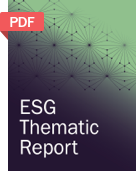Environmental, Social, and Governance (ESG) in the Leather Goods Industry
ESG assessment has become a preferred and significant approach for stakeholders to assess and invest in markets towards improving environmental, social standards, and governance standards in the industry.
As of 2021, the leather goods market was worth USD 407.92 billion and is expected to grow at a CAGR (compound annual growth rate) of 6.9% by 2030. A consumer driven market, where the demand is on the rise for trendy apparels, the market is one of those sectors where the performance is high. Equally, the industry has high scrutiny in terms of environmental and social responsibility. In terms of environment, the commercial exploitation of natural resources gradually leads to degradation of the environment creating an adverse impact on the environment, where biodiversity is a key impact area. The other challenging aspect is the social part of ESG, where human communities are adversely affected from the industrial manufacturing process. Depletion of natural resources due to commercial exploitation also negatively affects the environment.
ESG Trends
The leather goods industry is challenged with various aspects of ESG, where the environmental part is challenged with biodiversity exploitation and eutrophication, whereas in terms of social aspects, the manufacturing processes have a significant impact on the health of the local communities as well as people involved in the manufacturing process. Thus, the market receives significant attention from an ESG perspective, as challenges such as these are critical to both the production and performance of the companies in the market.
Globally, around 40% of the world’s forest is lost due to deforestation. As of today, around 10 million hectares of forest is lost per year due to deforestation. The majority of this is caused by the industry. Bark, which is an important component used for tanning the leather, is sourced from the trees, when used at industrial scale causes deforestation, by cutting down the trees at industrial scale.
Eutrophication is a phenomenon which takes place because of deforestation. In eutrophication, minerals such as nitrogen and phosphorus get deposited in the land and excessively deposited into waters, making the waters a dead zone for the animals. The leather industry, by extracting bark at industrial scale causing deforestation is responsible for increase in phosphorus and nitrogen levels, causing a major imbalance in the biodiversity i.e., eutrophication in water bodies. This increase in the phosphorus levels increases toxic levels and facilitates the growth of algae, killing fishes as well as the animals which depend on these water bodies.
The challenge in terms of social aspect is that the production involves tanning of the leather, where arsenic, a chemical compound, is linked to cancer and lung diseases. Communities living near leather manufacturing sites are adversely affected by this process.
In 2020, one of the key players in the industry has taken measures in this regard and taken up an initiative to produce more than 60% of its products from sustainable materials. They plan to achieve this by using vegan leather, a plant-based material. The same company has also initiated a policy for protecting the workers from toxic and hazardous substances while manufacturing leather goods and products.
The challenge here is that large players of the market have access to plant-based material i.e, vegan leather, due to the fiscal stature. However, the players who have lesser financial and infrastructural support take time to adapt to these changes.
Growth of Leather Goods Market
The scope for ESG in leather goods market is ample, the potential in the market is unexplored by the companies which have smaller financial stature There are a few policies, such as sustainable forest initiatives at international scale and foundations such as sustainable leather foundation, which provides framework for the companies in the leather industry, that create impact in terms of ESG. Furthermost of the internal policies are made by the companies out of their ethical values.
Key Companies in this theme
• Adidas
• Nike
• Richemont
• Hermes
• Prada group
Scope of the Leather Goods Industry ESG Thematic Report
• Macro-economic and ESG-variable analysis of the industry, including regulatory, policy, and innovation landscape
• Key insights on infrastructure developments and ESG issues affecting the theme
• Identify key initiatives and challenges within the industry
• Identify ESG leaders within the industry
• Understand key initiatives and the impact of companies within the sector to fuel an informed decision-making process
• Analysis of industry activities based on multi-media sources, including significant controversies and market sentiment
Key Benefits of Leather Goods Industry ESG Thematic Report:
• Offers a global perspective of the leather goods market and the policies and measures taken by the players, for overcoming the challenges faced in terms of Environment, Social and Governance.
• Key insights into the sustainability practices of major players in the market.


